The first Russian circumnavigation 1803-1806 Ivan Kruzenshtern and Yuri Lisyansky
The purpose of the expedition
Make the first round-the-world voyage in the history of the Russian fleet. Deliver and pick up goods from Russian America. Establish diplomatic contacts with Japan. Show the profitability of direct trade in furs from Russian America to China. To prove the benefits of the sea route from Russian America to St. Petersburg in comparison with the land route. Carry out various geographical observations and scientific research along the route of the expedition.
Expedition composition
Ships:
The three-masted sloop "Nadezhda", with a displacement of 450 tons, 35 meters long. Purchased in England especially for the expedition. The ship was not new, but it endured all the difficulties of sailing around the world.
Three-masted sloop "Neva", displacement 370 tons. Bought there especially for the expedition. Endured all the difficulties of sailing around the world, after which he was the first Russian ship to visit Australia in 1807.
Emperor Alexander I personally examined both sloops and allowed them to fly the military flags of the Russian Empire. The Emperor took the maintenance of one of the ships at his own expense, and the cost of operating the other was covered by the Russian-American company and one of the main inspirers of the expedition, Count N.P. Rumyantsev. Which ship who took - is not specified.
Personnel
 Head of the expedition Kruzenshtern Ivan Fedorovich.
Head of the expedition Kruzenshtern Ivan Fedorovich.
Age at the time of the start - 32 years.
He is also the captain of the expedition flagship of the sloop "Nadezhda".
On board the "Nadezhda" were:
warrant officers Thaddeus Bellingshausen and Otto Kotzebue, who later glorified the Russian fleet with their expeditions
Ambassador Rezanov Nikolay Petrovich (to establish diplomatic relations with Japan) and his retinue
scientists Horner, Tilesius and Langsdorf, artist Kurlyantsev
mysteriously, the famous brawler and duelist Count Fyodor Tolstoy, who went down in history as the American Tolstoy, also got into the expedition
The sailors were all Russian to one - that was the condition of Kruzenshtern.
The total number of the team is 65 people.

Sloop "Neva":
Commander - Yuri Fedorovich Lisyansky.
Age at the time of the start - 30 years.
The total number of the ship's crew is 54 people.
The holds of both ships contained iron products, alcohol, weapons, gunpowder, and many other things for delivery to Russian America and Kamchatka.
Start of the first Russian round-the-world expedition
The expedition left Kronstadt on July 26 (August 7), 1803. On the way, we went to Copenhagen, then to the small English port of Falmouth, where the ships were once again dug.
Canary Islands
The expedition approached the archipelago on October 19, 1803. They stayed in the harbor of Santa Cruz for a week and headed south on October 26.
Equator
On November 26, 1803, the ships flying the Russian flag "Nadezhda" and "Neva" crossed the equator for the first time and entered the Southern Hemisphere. According to the maritime tradition, the festival of Neptune was arranged.
South America
The shores of Brazil appeared on December 18, 1803. We stopped in the harbor of the city of Destero, where they stood for a month and a half to repair the Neva's mainmast. Only on February 4, 1804, both ships moved further south along the South American coast.
Cape Horn
Before going around Cape Horn, Kruzenshtern and Lisyansky agreed on a meeting place, since both understood that in this place the ships were easily swept away by bad weather. The first option for the meeting was Easter Island, the alternate one was Nukagiva Island. "Nadezhda" safely rounded Cape Horn and on 3 March 1804 sailed into the Pacific Ocean.
Nukagiva
Easter Island slipped through in strong winds, so Kruzenshtern went straight to the alternate meeting point, Nukagiva Island, where he arrived on May 7, 1804. On the way, the islands of Fetuga and Ouaguga from the Marquesas group were mapped. On May 10, the Neva approached Nukagiva. A week later, both ships set sail in the direction of the Hawaiian Islands.
Equator
Hawaiian Islands
The ships approached them on June 7, 1804. Here they were to part. "Neva" with a cargo of goods for the Russian-American company went in the direction of Alaska, to the Kodiak Island. "Nadezhda" headed for Kamchatka, from where it was necessary to go with the embassy to Japan and explore the island of Sakhalin. The meeting of both ships was now expected only in Macau in September 1805, where the "Nadezhda" will approach upon completion of the diplomatic mission, and the "Neva" - with a cargo of furs from Russian America.
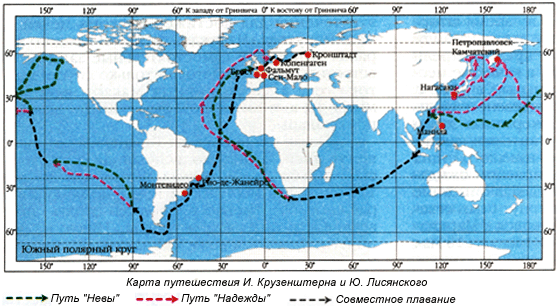
Journey of "Nadezhda"
Kamchatka
The "Nadezhda" entered Avacha Bay on July 14, 1804. The population of Petropavlovsk was then about 200 people. Governor General Koshelev arrived here from Nizhnekamchatsk (the then capital of the peninsula), who in every possible way contributed to the repair of the ship and preparation for the visit to Japan. The expedition was left by a doctor and an artist, and the brawler Tolstoy was forcibly "written off to the shore". On August 30, 1804, the Nadezhda headed for Japan.
Japan
It is known from the history of Japan that any foreign ships were prohibited from entering Japanese ports. And the inhabitants of the Isles of the Rising Sun were strictly prohibited from contacting foreigners. This forced self-isolation saved Japan from possible colonization and trade expansion by Europeans, and also helped to preserve its identity. Only the merchants of the Dutch East India Company were allowed to trade in the port of Nagasaki, the southernmost point of the country. The Dutch had a monopoly on trade with Japan and did not let competitors into their possessions, hid nautical maps with coordinates, etc. Therefore, Kruzenshtern had to lead the "Nadezhda" to Nagasaki almost at random, simultaneously surveying the Japanese shores.
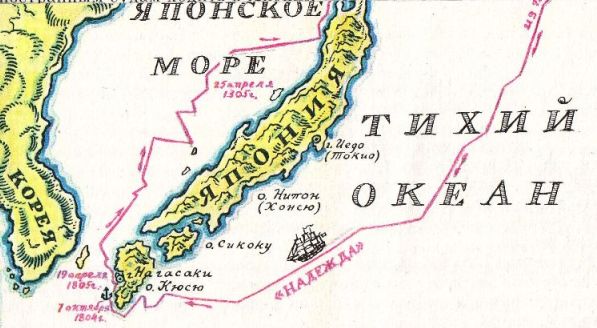
In Nagasaki
Kruzenshtern's ship with Ambassador Rezanov entered the harbor of Nagasaki on October 8, 1804. On board the Russians had several Japanese, who had once fallen to the Russians as a result of a crash, and whom the expedition carried with them as translators.
A Japanese representative entered the ship, asked hu-is-hu, they say, where and why did they come from. Then the Japanese pilot helped the "Nadezhda" enter the harbor, where they dropped anchor. Only Japanese, Chinese and Dutch ships were stationed in the harbor.
Negotiations with the Japanese
This topic deserves a separate story and a separate article. Let's just say that the Japanese "pushed" the Russian "diplomatic mission" in the port of Nagasaki until April 18, 1805 - five and a half months! And Kruzenshtern with Rezanov had to go home incessantly.

The Japanese emperor "paused" for a long time, then answered through his officials that there would be no agreements with the Russians, and he could not accept the gifts of the Russian emperor - several huge mirrors in expensive frames -. Say, Japan is not in a position to equally thank the emperor of the Russians because of its poverty. Laughter, and more! Either the Dutch did a good job here, or the Japanese themselves did not want any contacts with Russia.
True, the Japanese administration supplied it with food all the time the ship was in port. And she loaded the road with food, water and a lot of salt for free. At the same time, Kruzenstern was categorically forbidden to return along the western coast of Japan.
Return of "Nadezhda" to Kamchatka
Coming out of the Japanese "captivity", Kruzenshtern decided not to give a damn about the Japanese ban and went exactly along the western coast, putting it on the map. At sea he was his own master and was not afraid of anyone - past combat experience gave him every reason for this. He molested the shore several times and got to know this mysterious country as closely as he could. They managed to establish contacts with the Ainu - the inhabitants of the northern Japanese island of Hokkaido.
Sakhalin
The Nadezhda entered the Aniva Bay in the south of Sakhalin on May 14, 1805. The Ainu also lived here and the Japanese administration commanded. Kruzenshtern was determined to investigate Sakhalin in more detail, but Rezanov insisted on an early return to Kamchatka in order to report to St. Petersburg on the results of his "embassy".
Kamchatka
On June 5, the "Nadezhda" returned to Petropavlovsk-Kamchatsky. Rezanov went ashore, sent a report to the capital, and himself on a merchant ship departed for Russian America to Alaska. On July 5, 1805, Nadezhda again set out to sea and headed for Sakhalin. But Kruzenshtern was unable to go around Sakhalin and determine whether it was an island or a peninsula. On August 30, the "Nadezhda" team entered the Avacha Bay of Petropavlovsk for the third time. Kruzenshtern began to prepare for a campaign in Macau.
Macau
This is the name of the portuguese colony-fortress-port on the Chinese coast. Leaving Petropavlovsk on October 9, 1805, "Nadezhda" was in Macau on November 20. The Neva was nowhere to be seen.
Travels of the "Neva"
Russian America
The sloop "Neva" under the leadership of Lieutenant-Commander Lisyansky on July 10, 1804 approached Kodiak Island on the southern coast of Alaska. The island of ball is one of the first places for the capital justification of Russians in America. Lisyansky brought the ship to the harbor of St. Paul - a kind of administrative center of this Russian province. Here he learned that an armed attack by the local Indians had been carried out on the second center of the Russians - the Arkhangelsk fortress in the Sitka Bay, much south and east of Kodiak. The fortress was burned down, the inhabitants were killed. The conflict broke out not without the help and incitement of the Americans, by that time they began to actively penetrate these places.
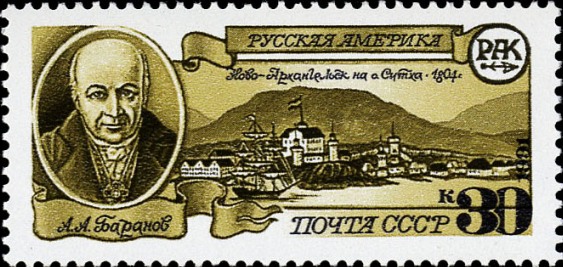
Alexander Andreevich Baranov - the legendary ruler of Russian America departed for the "war" to fight off the Arkhangelsk fortress with the help of friendly Russian Indians and Aleuts. Baranov left a message to Lisyansky, in which he asked to urgently come to Sitka to provide armed assistance. However, the Neva crew spent almost a month unloading the ship's holds and repairing the equipment. On August 15, the Neva headed towards Sitka.
Novoarkhangelsk - Sitka
On August 20, Lisyansky was already in Sitka Bay. Here he met Alexander Baranov, who made a strong impression on him. Together they worked out a plan for a military operation. The guns and sailors of the Neva played a decisive role in restoring the "status quo" in relations with the Tincklite Indians. Not far from the burnt old fortress, a new settlement Novoarkhangelsk was founded. On November 10, the Neva left Sitka and headed for Kodiak.
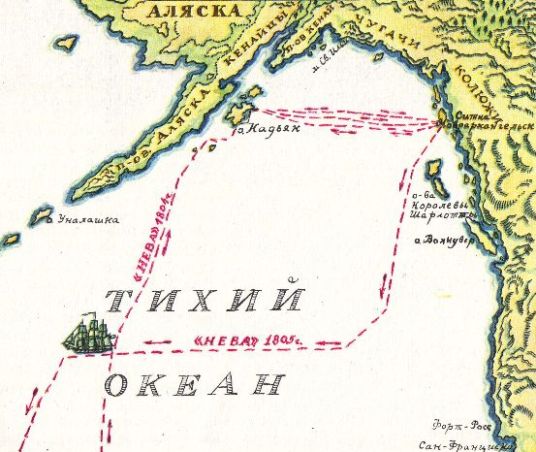
Back in Kodiak
"Neva" was already in five days. As winter was approaching, it was decided to spend the winter here, to renovate, rest and fill the holds with precious junk - the furs of the Russian-American Company. At the beginning of the next summer, on June 13, 1805, Lisyansky's ship left the harbor of St. Paul and headed for Sitka to pick up the furs prepared by Baranov, and then go to Macau.
Back in Sitka - Novoarkhangelsk
"Neva" appeared on June 22, 1805. During the winter, Baranov managed to rebuild the settlement, restore peace with the local Indians, and procure a large number of furs. Having loaded soft gold into the holds, Lisyansky headed for Macau on September 2, 1805.
In Macau
Kruzenshtern arrived in Macau on November 20, 1805. 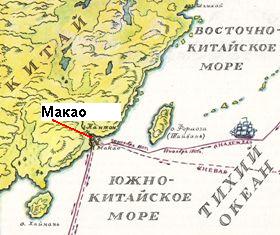 Lisyansky reached the Chinese shores only on December 3rd. Here I had to stay for more than two months, "getting used to" the local conditions, economic and political situation, maneuver, bargain. In this, both military sailors Kruzenshtern and Lisyansky showed remarkable abilities. And they emerged victorious in the trade war with local merchants. Instead of furs, the holds of the ships were filled with tea, porcelain and other goods that were liquid in Europe. February 9, 1806 "Nadezhda" and "Neva" left the Chinese coast and headed for their homeland.
Lisyansky reached the Chinese shores only on December 3rd. Here I had to stay for more than two months, "getting used to" the local conditions, economic and political situation, maneuver, bargain. In this, both military sailors Kruzenshtern and Lisyansky showed remarkable abilities. And they emerged victorious in the trade war with local merchants. Instead of furs, the holds of the ships were filled with tea, porcelain and other goods that were liquid in Europe. February 9, 1806 "Nadezhda" and "Neva" left the Chinese coast and headed for their homeland.
Across two oceans
The ships were scattered on the way to the Cape of Good Hope. The captains had previously agreed to meet at the island of St. Helena. Kruzenshtern arrived at St. Helena on May 3, 1806. Here he learned that Russia was at war with Napoleon and France. Without waiting for the Neva, Nadezhda went north to her native land, for safety deciding to go around England from the north, so as not to collide with the French in the English Channel.
Meanwhile, Lisyansky decided to set a kind of record - to go from China to Europe without calling intermediate ports. The ship no longer had heavy cargo, took enough food and water supplies, and went in full sail. Therefore, Lisyansky did not appear on St. Helena and, accordingly, did not know about the war with France. He calmly entered the English Channel, and there he decided to go to the British port of Portsmouth. Having rested in Portsmouth for a couple of weeks, on July 13, 1806, the Neva set out to sea again, and on August 5, 1806, she was already at home. And on August 19, 1806, the sails of the "Nadezhda" appeared in view of their native shores.
Thus ended the first round-the-world voyage of Russian sailors, an unprecedented campaign filled with dangers and adventures, interesting and significant events for history.
It should be said that from the point of view of benefits, the expedition fully justified itself, bringing considerable profits to merchants, glory to the Fatherland and forever inscribing the names of Russian navigators Ivan Kruzenshtern and Yuri Lisyansky in the history of navigation.
Emperor Alexander I awarded I.F. Kruzenshtern and all members of the expedition.
all officers received the following ranks,
commanders of the order of st. Vladimir 3 degrees and 3000 rubles each.
lieutenants 1000 each
warrant officers 800 rubles each for life pension
the lower ranks, at will, were dismissed and awarded a pension from 50 to 75 rubles.
By the highest order, a special medal was struck for all participants in this first round the world trip.
"Travel around the world in 1803, 1804, 1805 and 1806 on the ships" Nadezhda "and" Neva ", under the command of Lieutenant-Commander Kruzenshtern" in 3 volumes, with an atlas of 104 maps and engraved paintings. This was the name of the work, written personally by Kruzenshtern and published at the expense of the imperial cabinet., St. Petersburg, 1809. Subsequently, it was translated into many European languages.

Russian travelers and pioneers
Again
travelers of the era of great geographical discoveries



